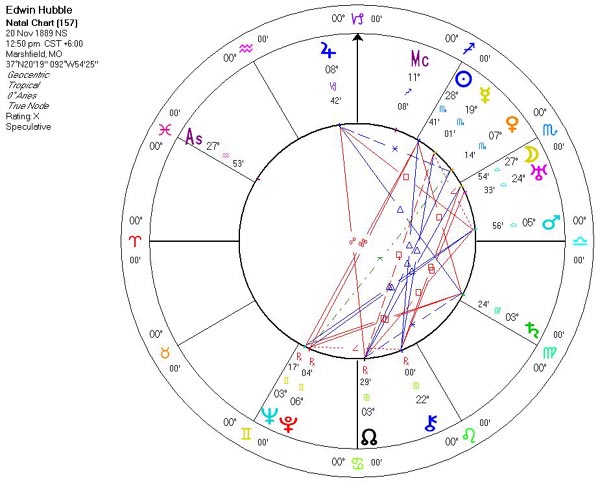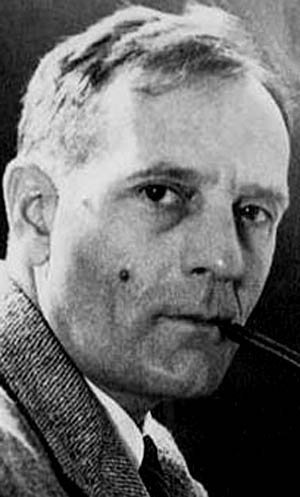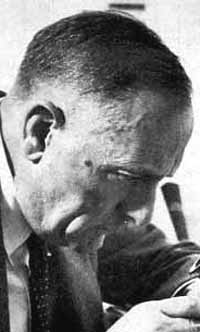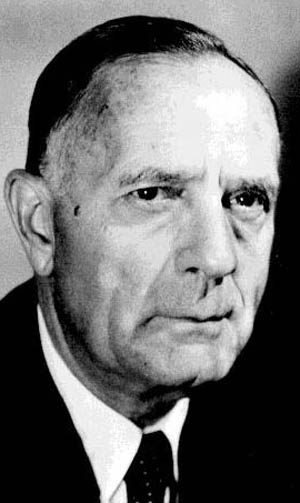Copyright Michael D. Robbins 2005
Astro-Rayological
Interpretation & Charts
Quotes
Biography
Images and Physiognomic Interpretation
Equipped with his five senses, man explores the universe around him and calls the adventure Science.
(Venus in Scorpio)The great spirals... apparently lie outside our stellar system.
The history of astronomy is a history of receding horizons.
We find them smaller and fainter, in constantly increasing numbers, and we know that we are reaching into space, farther and farther, until, with the faintest nebulae that can be detected with the greatest telescopes, we arrive at the frontier of the known universe.
"At the last dim horizon, we search among ghostly errors of observations for landmarks that are scarcely more substantial. The search will continue. The urge is older than history. It is not satisfied and it will not be oppressed."
"The universe is unfolding as it should."
"Observations always involve theory."
“Since the corresponding velocity of recession is the same fraction of the velocity of light, the nebulae in the most distant cluster observed, if they are actually receding, will appear 13 per cent fainter than they would appear if they were stationary. The difference is small but, fortunately, the measures can be made with fair accuracy. The results may be stated simply. If the nebulae are stationary, the law of red shifts is sensibly linear; red shifts are a constant multiple of distances. In other words, each unit of light path contributes the same amount of red shift. On the other hand, if the nebulae are receding, and the dimming factors are applied, the scale of distances is altered, and the law of red shifts is no longer linear.”
"The explorations of space end on a note of uncertainty... we measure shadows... we search among ghostly errors of measurement."
Edwin Hubble
Edwin HubbleEdwin Powell Hubble (November 20, 1889 – September 28, 1953) was an American astronomer, noted for his discovery of galaxies beyond the Milky Way and the cosmological redshift. Edwin Hubble was one of the leading astronomers of modern times and laid down the foundation upon which physical cosmology now rests.Biography
Edwin Hubble was born to an insurance executive in Marshfield, Missouri and moved to Wheaton, Illinois in 1889. In his younger days, he was noted more for his athletic abilities rather than his intellectual genius, although he did earn good grades in every subject, except for spelling. He won seven first places[1] and a third placing in a single high school track meet in 1906. That year he also set a state record for high jump in Illinois.His studies at the University of Chicago concentrated on mathematics and astronomy[citation needed] which led to a BS degree in 1910.Hubble also became a member of the Kappa Sigma Fraternity and in 1948 was named Kappa Sigma "man of the year". He spent the next three years as one of Oxford's first Rhodes Scholars, where he originally studied jurisprudence, before switching his major to Spanish and receiving the MA degree, after which he returned to the United States. Some of his British mannerisms and dress stayed with him all his life, occasionally irritating his more Americanized colleagues.
Returning to the United States he worked as a high school teacher and a basketball coach at New Albany High School in New Albany, Indiana (near Louisville), and practiced law in Kentucky. He served in World War I and quickly advanced to the rank of Major. He returned to astronomy at the Yerkes Observatory of the University of Chicago, where he earned a PhD in 1917 with a dissertation entitled "Photographic Investigations of Faint Nebulae".
In 1919 Hubble was offered a staff position by George Ellery Hale, the founder and director of Carnegie Institution's Mount Wilson Observatory, near Pasadena, California, where he remained until his death. He also served in the US Army at the Aberdeen Proving Ground during World War II. For his work there he received the Legion of Merit. Shortly before his death, Palomar's 200-inch Hale Telescope was completed; Hubble was the first to use it.
He died of a cerebral thrombosis on September 28, 1953, in San Marino, California. His wife, Grace, did not have a funeral for him and never revealed what was done with his body - it was apparently Hubble's wish to have no funeral service and be buried in an unmarked grave, or that he wanted to be cremated. As of 2007, the whereabouts of his remains are unknown.
Discoveries
Galaxies exist beyond the Milky Way
Hubble's arrival at Mount Wilson in 1919 coincided roughly with the completion of the 100-inch Hooker Telescope, then the world's largest telescope. Using the Hooker Telescope Hubble identified Cepheid variables (a kind of star; see also standard candle) in several nearby "nebulae" (including the Andromeda Galaxy). His observations in 1923–1924 conclusively proved that these objects were much more distant than previously thought and hence galaxies themselves rather than constituents of the Milky Way. Announced on January 1, 1925, this discovery fundamentally changed mankind's view of the universe.Hubble also devised a classification system for galaxies, grouping them according to their content, distance, shape, size and brightness
Redshift increases with distance
The 100 inch Hooker telescope at Mount Wilson Observatory that Hubble used to measure galaxy redshifts and discover the general expansion of the universe.Hubble was generally incorrectly credited with discovering[2] the redshift of galaxies. These measurements and their significance were understood before 1917 by James Edward Keeler (Lick & Allegheny), Vesto Melvin Slipher (Lowell), and Professor William Wallace Campbell (Lick) at other observatories. Combining his own measurements of galaxy distances with Vesto Slipher's measurements of the redshifts associated with the galaxies, Hubble and Milton L. Humason discovered a rough proportionality of the objects' distances with their redshifts. Though there was considerable scatter (now known to be due to peculiar velocities), Hubble and Humason were able to plot a trend line from the 46 galaxies they studied and obtained a value for the Hubble-Humason constant of 500 km/s/Mpc, which is much higher than the currently accepted value due to errors in their distance calibrations.[3] In 1929 Hubble and Humason formulated the empirical Redshift Distance Law of galaxies, nowadays termed simply Hubble's law, which, if the redshift is interpreted as a measure of recession speed, is consistent with the solutions of Einstein’s equations of general relativity for a homogeneous, isotropic expanding space. Although concepts underlying an expanding universe were well understood earlier, this statement by Hubble and Humason led to wider scale acceptance for this view. The law states that the greater the distance between any two galaxies, the greater their relative speed of separation.This discovery was the first observational support for the Big Bang theory which had been proposed by Alexander Friedmann in 1922. The observed velocities of distant galaxies, taken together with the cosmological principle appeared to show that the Universe was expanding in a manner consistent with the Friedmann-Lemaître model of general relativity. In 1931 Hubble wrote a letter to the Dutch cosmologist Willem De Sitter expressing his opinion on the theoretical interpretation of the redshift-distance relation[4]:
"... we use the term 'apparent velocities' in order to emphasize the empirical feature of the correlation. The interpretation, we feel, should be left to you and the very few others who are competent to discuss the matter with authority."
Today, the 'apparent velocities' in question are considered to be artifacts of a coordinate transformation that occurs in an expanding space. Light traveling through stretching space will experience a Hubble-type redshift, a mechanism different from the Doppler effect.In the 1930s Hubble was involved in determining the distribution of galaxies and spatial curvature. This data seemed to indicate that the universe was flat and homogeneous, but there was a deviation from flatness at large redshifts. According to Allan Sandage,
"Hubble believed that his count data gave a more reasonable result concerning spatial curvature if the redshift correction was made assuming no recession. To the very end of his writings he maintained this position, favouring (or at the very least keeping open) the model where no true expansion exists, and therefore that the redshift "represents a hitherto unrecognized principle of nature."[5]
There were methodological problems with Hubble's survey technique that showed a deviation from flatness at large redshifts. In particular the technique did not account for changes in luminosity of galaxies due to galaxy evolution.Earlier, in 1917, Albert Einstein had found that his newly developed theory of general relativity indicated that the universe must be either expanding or contracting. Unable to believe what his own equations were telling him, Einstein introduced a cosmological constant (a "fudge factor") to the equations to avoid this "problem". When Einstein heard of Hubble's discovery, he said that changing his equations was "the biggest blunder of [his] life".[6]
] Other discoveries
Hubble discovered the asteroid 1373 Cincinnati on August 30, 1935. He also wrote The Observational Approach to Cosmology and The Realm of the Nebulae around this time.Nobel Prize
Hubble spent much of the later part of his career attempting to have astronomy considered an area of physics, instead of being its own science. He did this largely so that astronomers - including himself - could be recognized by the Nobel Prize Committee for their valuable contributions to astrophysics. This campaign was unsuccessful for a long time. The Nobel Prize Committee eventually decided that astronomical work would be eligible for the physics prize. Unfortunately for Hubble, this occurred in 1953 some months after his death. The Nobel Prize is never awarded posthumously.DATE OF BIRTH 20 November 1889
PLACE OF BIRTH Marshfield, Missouri
DATE OF DEATH 28 September 1953
PLACE OF DEATH San Marino, CaliforniaEdwin Powell Hubble
was born in the small town of Marshfield, Missouri, USA, on November 29th, 1889. In 1898, His family moved to Chicago, where he attended high school. Young Edwin Hubble had been fascinated by science and mysterious new worlds from an early age, having spent his childhood reading the works of Jules Verne (20,000 Leagues Under the Sea, From the Earth to the Moon), and Henry Rider Haggard (King Solomon's Mines), Edwin Hubble was a fine student and an even better athlete, having broken the Illinois State high jump record. When he attended University, Hubble continued to excel in sports such as basketball and boxing, but he also found time to study and earn an undergraduate degree in mathematics and astronomy.Edwin Hubble went to Oxford University on a Rhodes scholarship, where he did not continue his studies in astronomy, but instead studied law. At this point in his life, he had not yet made up his mind about pursuing a scientific career.
In 1913, Hubble returned from England and was admitted to the bar, setting up a small practice in Louisville Kentucky; but it didn't take long for Hubble to realize he wasn't happy as a lawyer, and that his real passion was astronomy, so he studied at the Yerkes Observatory, and in 1917, received a doctorate in astronomy from the University of Chicago.
Following a tour of duty in the first World War, Hubble took a job at the Mount Wilson Observatory in California, where took many photographs of Cepheid variables through 100 inch reflecting Hooker telescope, proving they were outside our galaxy, and determining the existence of several other galaxies such as our own milky way, which had until then been believed to be the universe.
Hubble had also devised a classification system for the various galaxies he observed, sorting them by content, distance, shape, and brightness; it was then he noticed redshifts in the emission of light from the galaxies, seeing saw that they were moving away from each other at a rate constant to the distance between them. From these observation, he was able to formulate Hubble's Law in 1929, helping astronomers determine the age of the universe, and proving that the universe was expanding.
It is interesting to note that In 1917, Albert Einstein had already introduced his general theory of relativity, and produced a model of space based on that theory, claiming that space was curved by gravity, therefore that it must be able to expand or contract; but he found this assumption so far fetched, that he revised his theory, stating that the universe was static and immobile. Following Hubble's discoveries, he is quoted as having said that second guessing his original findings was the biggest blunder of his life, and he even visited Hubble to thank him in 1931.
Edwin Powell Hubble's observations had revolutionized astronomy, not only did we realize there were other galaxies in the universe besides our own, we also were able to determine that if the universe was expanding outwards, it must have been coming from a central point, and that something must have caused that expansion to begin with, giving birth to the Big Bang Theory.
Edwin Hubble left Mount Wilson in 1942, determined help fight the Nazis in World War II; at first he wanted to join the armed forces as he had done during the first World War, but he realized he could do more for his country by offering his services as a scientist. In 1946, he was awarded the Medal of Merit, for exceptional conduct in providing outstanding services to citizens.
This was not the last of the honors bestowed upon Hubble, as in 1948, he was also elected Honorary Fellow of Queen’s College, Oxford, for his notable contributions to Astronomy.
After the war ended, Hubble resumed his work at Mount Wilson, where he had little trouble convincing his employers of the need for an even greater telescope than the current 100 inch reflector model, so they could further explore the universe outside our galaxy. Hubble was instrumental in the design of the Hale Telescope, which was set up at the Mount Palomar Observatory.
Edwin Hubble had the honor of being the first to use it.
When asked what he hoped to find with the new telescope by the BBC, Hubble replied "We hope to find something we hadn't expected."
Edwin Powell Hubble continued his work at both the Mount Wilson and Mount Palomar observatories until his death from from a cerebral thrombosis, on September 28, l953. He will forever be remembered as the father of observational cosmology and as a pioneer of the distant stars.






